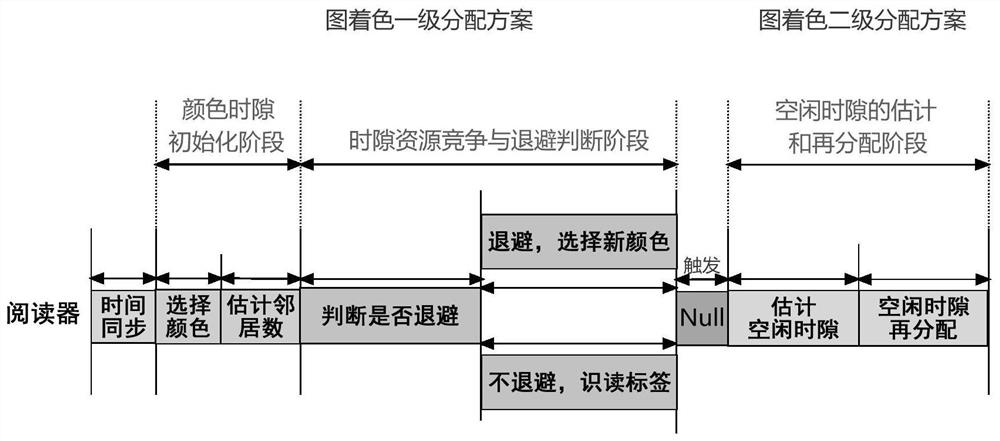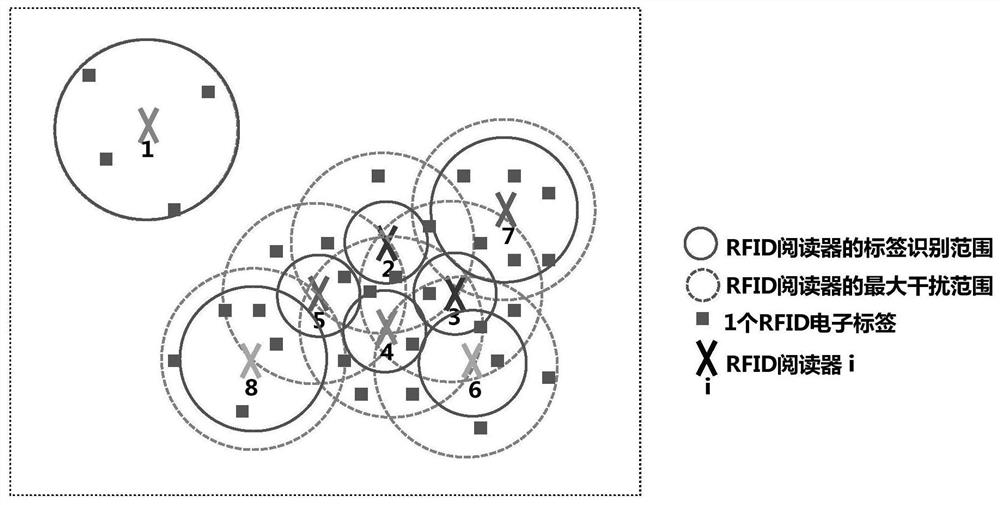A two-level distribution method for anti-collision map coloring of RFID readers
A distribution method and reader technology, applied in the field of communication, can solve problems such as low network throughput rate of RFID readers, waste of time slot resources for secondary collisions of RFID readers, etc., to maximize throughput rate and tag recognition rate, and reduce The effect of secondary collision and efficient utilization
- Summary
- Abstract
- Description
- Claims
- Application Information
AI Technical Summary
Problems solved by technology
Method used
Image
Examples
Embodiment 1
[0036] Such as figure 1 As shown, a RFID reader anti-collision graph coloring two-stage distribution method, the method includes a two-stage graph coloring distribution scheme executed sequentially in each round, which are respectively a graph coloring primary distribution scheme and a graph coloring secondary distribution scheme;
[0037] The graph coloring primary allocation scheme involves the color time slot initialization phase and the time slot resource competition and backoff judgment phase, and the graph coloring secondary allocation scheme involves the free time slot estimation and reallocation phase;
[0038] Color time slot initialization stage: RFID reader network has four color time slots, each RFID reader randomly selects a color time slot as the working time slot, and estimates the number of neighbor RFID readers within its interference range, according to the neighbor Create a color exchange table based on the number of RFID readers;
[0039] Time slot resourc...
Embodiment 2
[0056] Such as figure 1 , figure 2 , image 3 , Figure 4 , Figure 5 and Figure 6 shown. figure 1 It is a block diagram of the two-level allocation scheme of anti-collision graph coloring for RFID readers in this embodiment. The block diagram includes a first-level scheme and a second-level scheme for RFID reader graph coloring, and the RFID reader first executes the first-level scheme of graph coloring under the system time synchronization command . When the RFID reader receives the start command sent by the system, each RFID reader randomly selects a color time slot, estimates the number of neighboring RFID readers, and establishes a color exchange table. Then, the RFID reader responds according to the system time synchronization command. When the selected color time slot arrives, the targeted RFID reader broadcasts a beacon signal. If the target RFID reader does not detect a beacon collision, the RFID reader recognizes the RFID electronic tag; if the target RFID ...
PUM
 Login to View More
Login to View More Abstract
Description
Claims
Application Information
 Login to View More
Login to View More - R&D
- Intellectual Property
- Life Sciences
- Materials
- Tech Scout
- Unparalleled Data Quality
- Higher Quality Content
- 60% Fewer Hallucinations
Browse by: Latest US Patents, China's latest patents, Technical Efficacy Thesaurus, Application Domain, Technology Topic, Popular Technical Reports.
© 2025 PatSnap. All rights reserved.Legal|Privacy policy|Modern Slavery Act Transparency Statement|Sitemap|About US| Contact US: help@patsnap.com



